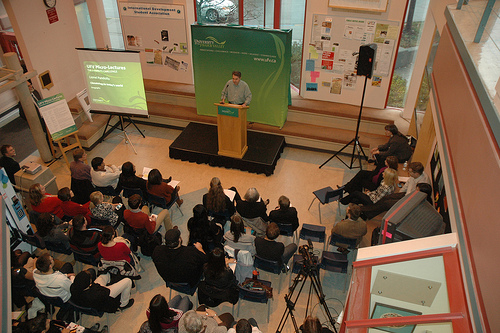Print Edition: November 30, 2011
“Green means go, yellow means you have 30 seconds left, and red means you’re out of there!”
These were the instructions given by associate vice-president of research and graduate studies Yvon Dandurand as he outlined the ground rules for the third edition of UFV’s popular microlectures series.
Sixteen professors representing 12 UFV departments took the two-minute challenge, presenting summaries of their research projects for an eager crowd of students and colleagues at the Road Runner Café on UFV’s Abbotsford campus last Wednesday.
“We call them microlectures, but they are major events,” Dandurand said.
The concept behind a microlecture is simple: researchers are given a strict time-limit of two minutes to deliver as much information as they can about their current project. In this way, the event is similar to student elevator pitch competitions held by other universities’ business departments. The challenge is how to most effectively generate interest in one’s research in such a short timespan among researchers and students from other backgrounds of study.
According to Satwinder Bains, who presented on her research into the development of racial and personal identity of South Asian students here at UFV, there are three key elements to any successful microlecture.
“You need the premise, a little bit of findings, and you need the hook,” she said. “It’s really hard to take 40 or 50 pages of a journal article you wrote and size it into one and a half pages and try to present it in two minutes.”
The condensed approach was effective as it kept the event’s running time well within the attention span of most of the attendees. In less than 40 minutes, audience members heard about the latest research across a wide variety of disciplines, from geography to linguistics and communications to criminology.
“What we wanted to do was get the word out on research and what’s happening at UFV with respect to research,” explained Brad Whittaker, director of research services.
Whittaker also emphasized the importance of the event’s location to its success. The Road Runner Café – momentarily transformed into a makeshift lecture hall with a stage, podium, and projector screen covering the large windows and rows of deck chairs filling the small space – is one of the school’s highest-traffic areas thanks to its proximity to the transit loop. At the end of the 40 minute session, it was standing-room-only with audience members spilling out into the hallways and leaning over the second-level railing to listen in.
To the left of the stage, a traffic light rigged to change colours according to the amount of time remaining cast a tinted glow across the podium. This meant that the audience knew immediately when a professor was nearing the end of their allotted time, if the increasingly rapid metre of the presenter’s speech was not already enough to give this away.
Satwinder Bains explained the sense of panic when the yellow light comes on.
“It’s like oh my god, oh my god, I have to finish now,” she said. “You’re prepared for the yellow light, but there’s so much more to tell and it feels like you’re leaving people hanging.”
First up was Eric Talvila, an instructor in the mathematics department who presented on distributional integrals, a revolutionary new theory that allows students and researchers to effectively bypass the complicated manoeuvres of twentieth century mathematics once required to achieve the same results.
“It’s kind of like jumping from the telegraph right to the cellphone without ever using the land line,” he said. “It’s a nice way to bring undergrads right to the forefront of research.”
Talvila’s approach was catered to a diverse audience. Instead of going into details about the math behind his research, he chose to describe the implications for undergraduate research.
“We have introductory math courses called Calculus I and Calculus II,” he explained. “I need to get you up to about Calculus XV in one minute and 50 seconds.”
One theme that emerged during the brief event was a general focus on researching local issues. Annette Vogt’s presentation discussed the success of extrajudicial alternatives to incarceration of young offenders in the Fraser Valley, while Tom Baumann spoke about efforts at the newly-commissioned Berry Resource Centre to solve pollination problems associated with declining honeybee populations.
English professor Jamin Pelkey’s use of analogies from biology in linguistics demonstrated the inter-disciplinary potential of these events. His current research looks at the use of three categories from evolutionary biology in the study of language change: ecology, or environmental influences; phylogeny, or inherited influences; and ontogeny, or areas where the two prior categories converge.
Pelkey’s belief is that, “this three-way distinction could help linguistics out of a rut.”
“If linguists embrace the fact that languages are always in process, language varieties could be reimagined as organisms or species growing through space and time, being conditioned by both the environment and determined by inherited traits,” he said.
Satwinder Bains said that these events are important in building a sense of community across the disciplines at UFV.
“I feel that sometimes we don’t have enough time to read other people’s work because, at this level, you’re so concerned with your own area that you can’t branch out,” she said. “I was so fascinated with the issues of education, biology, math and agriculture.”
According to Brad Whittaker, UFV students will have the chance to present on their own research work at a similar event planned for March 2012. Unlike professors, students will have an extra minute to help reduce the stress.
“A lot of students who do research here go on to graduate school; they have to make themselves known,” Whittaker said, encouraging students to take advantage of the opportunity to talk about their undergraduate work.
“So come out and tell us what you’re doing. Last year the student research day and presentation was fantastic,” he said. “I’m not exaggerating, it was great.”


